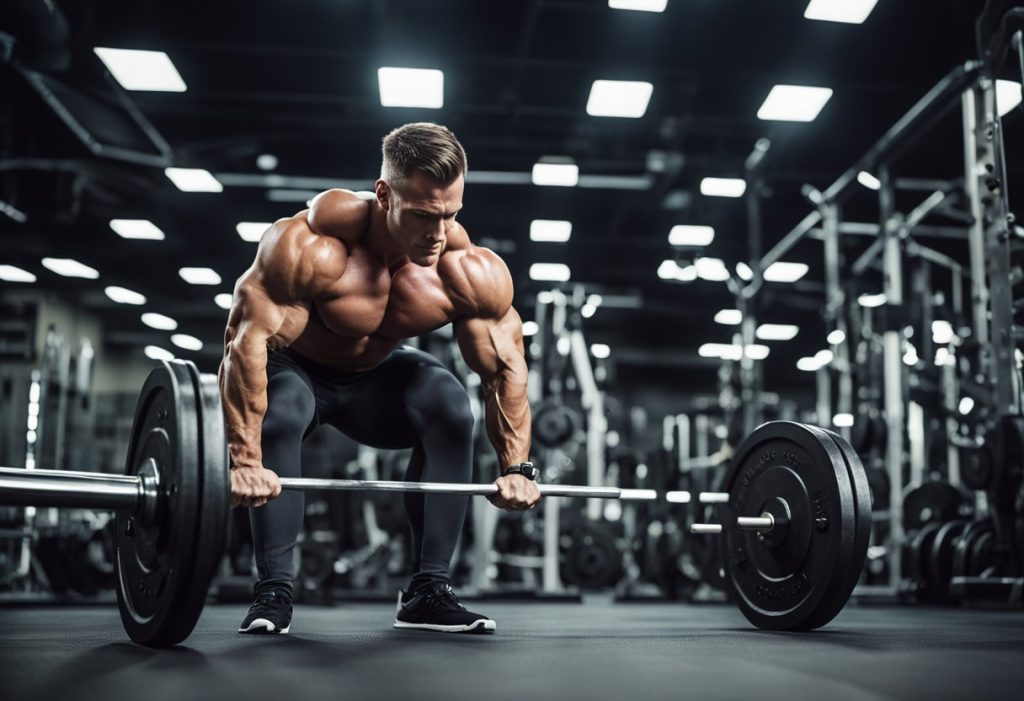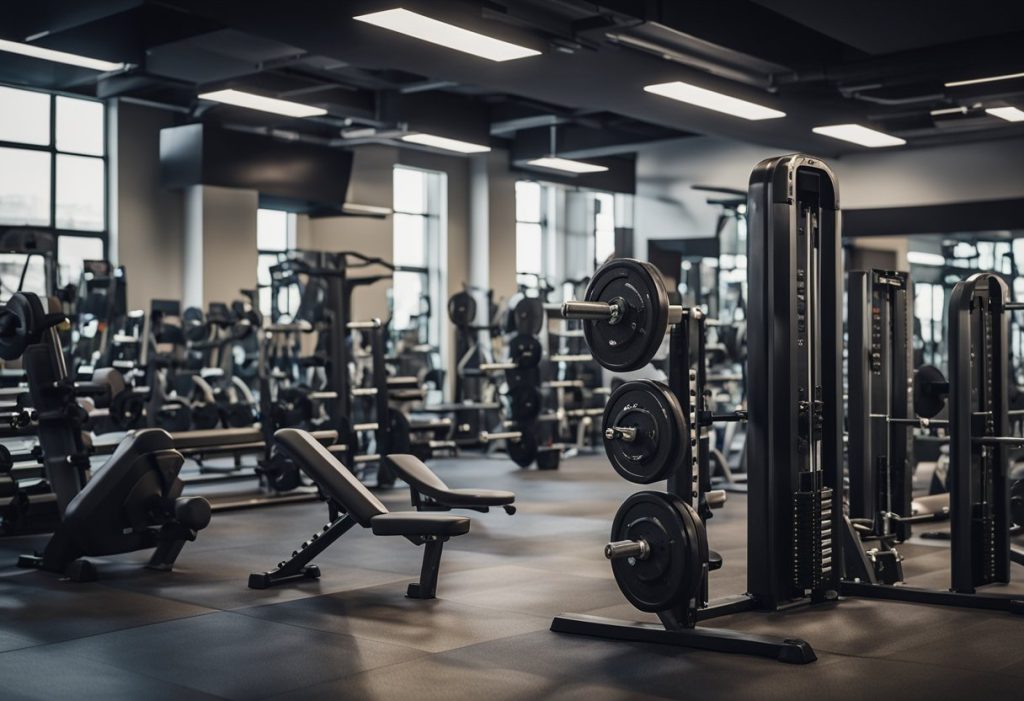
If you are into fitness, you might be wondering “How many hours do bodybuilders spend in the gym?” This comprehensive guide explores the world of bodybuilding, including the definition of a bodybuilder, their workout duration, and training schedules. We’ll delve into factors influencing their workout routines, nutrition, and recovery techniques.
Who Is a Bodybuilder?
Many people, including myself, have followed training routines similar to those of bodybuilders at times. However, it is important to recognize that most of us who go to the gym are recreational lifters and should not necessarily train in the same way as bodybuilders. So who is a bodybuilder?
A bodybuilder is a person who lifts heavy weights to build, control, and develop their muscles via hypertrophy. They engage in the practice of progressive resistance exercise to make their muscles bigger and aim to build an impressive physique for competitive exhibition or aesthetic purposes. This is achieved by maintaining a low body fat percentage.
The average body fat percentage of bodybuilders varies depending on the stage of competition preparation. During the general preparation phase, female bodybuilders have body fat levels ranging from 15.3% to 25.2%, while male bodybuilders have levels ranging from 9.6% to 16.3%.
However, close to competition, body fat levels significantly decrease. Female bodybuilders have levels ranging from 8.1% to 18.3%, and male bodybuilders have levels ranging from 5.8% to 10.7%.
Now that we have a clear understanding of who bodybuilders are and how they differ from recreational lifters, let’s take a step further and discover how long bodybuilders workout.
How Many Hours Do Bodybuilders Spend in the Gym?

A bodybuilder’s workout session typically lasts between 60 and 90 minutes on average, but the duration can vary depending on factors such as experience level, the muscles being worked, the timing and requirements of the competition, and the number of exercises performed.
It’s not uncommon for bodybuilders to have varying training durations. Some may choose to train for only an hour or less, while others may dedicate up to 4 hours a day to their training. Arnold Schwarzenegger, during the peak of his career, would train twice a day for 2-3 hours per session.
What is the Typical Workout Schedule for a Bodybuilder?
Bodybuilders typically train 5-7 days per week, with each workout lasting between 60-90 minutes. Their workouts are intense and require a lot of energy.
The typical workout schedule for a bodybuilder involves different phases of training. During the off-season phase, bodybuilders typically perform 3-6 sets per exercise, with 7–12 repetitions per set and 61–120 seconds of recovery between sets and exercises.
However, as the competition approaches, the training practices change. Bodybuilders reduce the number of sets per exercise, increase the repetitions per set, and decrease the recovery time between sets and exercises. This alteration is done to increase muscle definition.
In addition to resistance training, bodybuilders also incorporate aerobic exercise into their routine. Proper nutrition and supplementation are also considered important for bodybuilding competitors.
The majority of bodybuilders follow a split routine, with approximately 70% of bodybuilders following a 5-split routine and 30% following a 3-split routine.
In a 5-split routine, the body is split into five parts, typically the chest, back, arms, legs, and shoulders, with each part trained on a different day. This allows focused training on each muscle group and sufficient recovery time, with each group typically being trained once per week.
On the other hand, a 3-split routine divides the body into three parts, commonly the upper body, the lower body, and a third category focusing on either push/pull exercises or specific muscle groups.
In simple terms, in a 5-split routine, each major muscle group is trained once per week, while in a 3-split routine, each major muscle group is trained twice per week.
To illustrate the concept of 5-split and 3-split routines, here are practical examples in a table:
5-Split Routine
| Day | Muscle Group Focused On |
|---|---|
| Monday | Chest |
| Tuesday | Back |
| Wednesday | Rest Day |
| Thursday | Arms |
| Friday | Legs |
| Saturday | Shoulders |
| Sunday | Rest Day |
3-Split Routine
| Day | Muscle Group Focused On |
|---|---|
| Monday | Upper Body |
| Tuesday | Lower Body |
| Wednesday | Rest or Active Recovery |
| Thursday | Upper Body |
| Friday | Lower Body |
| Saturday | Core and Cardio |
| Sunday | Rest Day |
What Factors Influence a Bodybuilder’s Workout Schedule?

At this point, you should have a clear understanding of who bodybuilders are, how many hours they train, and what their workout schedules look like with practical examples. So, what factors influence their schedules?
1. Goals and Experience Level
- Beginner vs. Pro Bodybuilder: A beginner’s workout schedule might be less intense and more focused on learning proper techniques and building a foundation. In contrast, professional bodybuilders often engage in more rigorous and specialized routines to maximize muscle hypertrophy and prepare for competitions.
- Competitive vs. Recreational Bodybuilding: Competitive bodybuilders might train more frequently, focusing on each muscle group with high intensity, especially during the pre-contest phase. Recreational bodybuilders may have more flexibility in their schedules, focusing on overall fitness and muscle growth without the intensity of competition prep.
2. Muscle Group and Training Type
- Large vs. Small Muscle Groups: Training schedules often vary depending on the muscle groups targeted. Larger muscle groups like the legs or back might require more recovery time compared to smaller groups like the biceps or triceps.
- Hypertrophy vs. Strength Training: The type of training also influences the schedule. Hypertrophy training, aiming for muscle growth, might involve more sessions per week per muscle group, while strength training may focus on heavier lifts with longer rest periods.
3. Workout Frequency and Duration
- Days Per Week: The number of days a bodybuilder trains can range from 5-7 days per week, depending on their goals and recovery needs. During the off-season, the frequency might be lower compared to the pre-contest phase.
- Workout Duration: Typically, bodybuilders spend 60–90 minutes per workout session, but this can extend to 2-3 hours for professionals, especially when including cardio and additional training elements.
4. Cardio and Rest Periods
- Incorporation of Cardio: The amount and intensity of cardio will depend on the bodybuilder’s current phase (off-season vs. pre-contest) and individual goals.
- Rest and Recovery: Adequate rest between workouts is crucial to allow for muscle recovery and growth. This includes not only days off from the gym but also sufficient sleep and possibly active recovery practices.
5. Seasonal Adjustments
- Off-Season vs. Pre-Contest: Off-season might focus more on muscle building with higher calorie intake, while pre-contest phases involve more detailed work on the definition and cutting of body fat.
6. Supplementation and Nutrition
- Use of Supplements: Certain supplements might allow for quicker recovery, thus impacting the frequency of training sessions.
- Dietary Considerations: Caloric intake, macronutrient balance, and meal timing can all impact energy levels and recovery, thus influencing the workout schedule.
What Role Does Cardio Play in a Bodybuilder’s Workout?

Cardiovascular training is often included to improve the activity of the circulatory system, heart, and respiratory organs and increase endurance.
Bodybuilders often perform aerobic exercises in a fasted state during the off-season to reduce body fat, and as competition approaches, they typically increase the volume of these exercises to help lower body fat further, thereby indirectly enhancing muscle definition.
Should You Train Like a Bodybuilder?
The answer is no. Training like a bodybuilder involves specific training routines designed for muscle hypertrophy, with periods of different intensity load, training volume, and exercise type.
Bodybuilders often adopt specific dietary practices, such as high protein intake and manipulation of carbohydrate and fat intake during different phases, which can increase the risk of developing eating disorders.
It is important to note that bodybuilders often use anabolic steroids and other ergogenic aids, which may have negative health effects.
Therefore, while bodybuilding training methods may be effective for muscle growth, it is crucial to consider the potential risks and side effects associated with these practices.
Just adopt a more balanced and evidence-based approach to training and nutrition, focusing on natural methods and avoiding the use of performance-enhancing substances.
How Often Should You Workout?
As recreational lifters, we should not copy the rigorous schedules of professional bodybuilders. The key is to find a balance that allows for effective training while also providing sufficient time for recovery and accommodating our daily life commitments.
Most recreational lifters find success with a workout routine that fits into their weekly schedule without causing burnout or overtraining. A common approach that I also use is training 3-5 days per week.
Each workout session should, ideally, last between 60 to 90 minutes. This duration is long enough to cover all necessary exercises without overtaxing the body.
However, the exact number of days can vary based on your schedule, fitness goals, and how quickly your body recovers.
Pay attention to how your body responds to training. If you feel fatigued or notice a decrease in performance, it may be a sign to reduce the frequency or intensity of your workouts.
How Long Should a Beginner Workout Last?
As a beginner, your workout should typically last between 30 to 60 minutes. This allows you to build a consistent exercise habit, master proper form and technique, and recover well.
I remember as a beginner, I would spend over 2 hours every day in the gym, 6 days a week, beating up my body and wondering why I wasn’t making any progress.
This meant working out without fully recovering and, more often than not, with poor form in almost all the exercises.
If you are starting, do not make the same mistake. Be patient and master the basics before doing long workout sessions.
What Factors Influence the Workout Duration?
As you progress in your journey, you will notice that you’ll need to make some adjustments to your workout schedule, routine, and session duration. Several factors can influence how long you spend in the gym:
Training Goals
Specific objectives like muscle building, strength improvement, endurance, or weight loss dictate workout length and intensity.
Fitness Level
Increased fitness may require longer sessions with more advanced exercises.
Workout Intensity
High-intensity workouts might be shorter but more demanding, while low-intensity sessions could be longer.
Recovery Needs
The required rest between workouts can affect the time you spend in the gym.
Time Availability
You will need to adjust your schedule to accommodate all other commitments, e.g. work.
Muscle Group Focus
Time varies in split routines targeting different muscle groups each day.
Types of Exercises
A mix of strength, cardio, and flexibility exercises, for example, can alter session duration.
Adaptation and Plateauing
To avoid progress stalls, you’ll need to adjust your workout duration and intensity. However, avoid making changes to your workout routine too often. Sticking to a workout routine for a significant period of time is important for tracking gains. A sweet spot, according to most fitness experts, is 6–8 weeks.
Nutrition and Hydration
You will have to adjust your workout sessions depending on your nutrition and hydration status. You will realise that these two factors have a huge impact on energy levels.
Mental Focus and Motivation
Your mental state and motivation influence the time and energy you spend in the gym.
Availability of Weights and Machines
Limited or high demand for equipment can extend your gym time, especially during peak hours.
Gym Crowding
The number of people in the gym affects access to equipment and space, potentially leading to longer wait times and extended workouts.
How Can You Save Time at the Gym?
Let’s face it. Not all the days will be the same at the gym. Sometimes you will need to spend shorter times than usual while still maximising the gains. Here are some effective strategies to save time at the gym.
Do Compound Lifts
Compound lifts, such as squats, deadlifts, and bench presses, work multiple muscle groups simultaneously. Incorporating these into your routine means you’re efficiently targeting various parts of your body within a single exercise. This is a huge time saver.
Have a Plan
Before stepping into the gym, have a clear workout plan. Knowing exactly what exercises, sets, and reps you’re going to do eliminates guesswork and downtime, allowing for a smoother and quicker workout.
Know the Gym Layout
Familiarize yourself with the layout of your gym. Knowing where each piece of equipment is located saves time spent wandering around looking for what you need next in your workout.
Supersets
Supersets involve performing two exercises back-to-back with minimal rest. This method not only saves time but also keeps the intensity of your workout high. For example, you could pair a bicep exercise with a tricep exercise.
Time Your Rest Times
Keep track of your rest periods. Use a timer to ensure you’re not resting too long between sets. This helps maintain a steady pace and prevents prolonged breaks.
Avoid Peak Hours
Try to visit the gym during off-peak hours. Fewer people means more availability of equipment and less time waiting, leading to a more efficient workout session.
Final Words: How Long Do Bodybuilders Workout?
In conclusion, most bodybuilders tend to work out for 60-90 minutes. This is because bodybuilding requires a lot of time and dedication to achieve the desired results.
When it comes to frequency, bodybuilders typically train 5-7 days a week, working each muscle group 1-2 times a week.
You can borrow some lessons from how bodybuilders train but tailor your routine to fit your goals and prioritize post-workout recovery.
Frequently Asked Questions on Bodybuilding
What is bodybuilding?
Bodybuilding is a form of physical exercise and body modification involving intensive workouts targeting specific muscle groups to increase muscle mass and achieve a sculpted physique. It is popular among both competitive bodybuilders and individuals seeking to build muscle for personal fitness and aesthetics.
How Long Should a Workout Be?
A workout should typically be between 60 to 90 minutes. This duration allows for a thorough routine including warm-up, main exercises, and cool-down, ensuring a balanced workout. If you are a beginner, start with 30-60 minutes as you walk your way up.
How many days per week should a beginner bodybuilder work out?
For a beginner bodybuilder, it is recommended to start with 3-4 days per week of training sessions with adequate rest between workouts to allow muscle growth and recovery.
How many times a week do pro bodybuilders work out?
Professional bodybuilders typically engage in 5-7 days per week of intensive workouts, incorporating specific body part training, such as leg day, to maximize muscle growth and overall strength and conditioning.
What are the common practices of competitive bodybuilders?
Competitive bodybuilders often follow structured workout routines targeting large muscle groups and incorporating strength and conditioning research into their training to achieve optimal muscle hypertrophy and physique development.